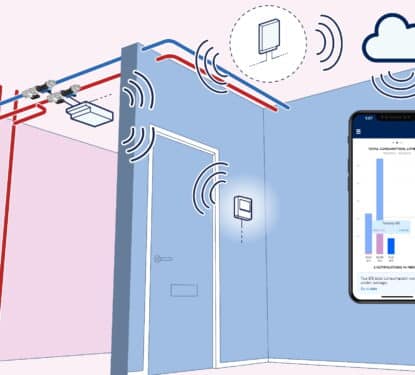Most property managers know their buildings are hemorrhaging money through inefficient systems. The problem? They have no idea where to start looking.
Devon Newton, VP of Property Management at Stiles, faced this exact challenge with 110 East, a new Class A development in Charlotte’s Southpark district. Despite managing 116 properties across the Southeast, she found herself drowning in “geek speak” and vendor finger-pointing when the building went live.
This podcast offers a blueprint for any property manager stuck in what Newton calls the “Efficiency Paralysis Cycle” – where low visibility, technical complexity, and budget constraints keep hundreds of thousands in savings locked away.
Stiles Problem: Too Much Tech, Too Little Understanding
Stiles built 110 East with Shorenstein as a flagship development, designed to bring South Florida-style Class A office to Charlotte. It was loaded with cutting-edge technology. That was precisely the problem.
“Every vendor had their own system,” Newton explains. “They design it, install it, and operate it in a silo. When things go wrong, they point fingers.”
Stiles needed what she calls “one throat to choke” – a single point of accountability that could translate technical jargon, coordinate vendors, and ensure systems actually worked as promised. This wasn’t about adding more technology. It was about making existing systems deliver value.
So Stiles hired Intelligent Buildings to be that translator. What started as a coordination exercise uncovered something unexpected: massive savings hiding in plain sight.
The First Win: $300K Saved Before Construction Finished
The initial breakthrough came during construction on the Distributed Antenna System (DAS) – the infrastructure that ensures mobile coverage throughout the building.
Rob Murchison from Intelligent Buildings reviewed the scope of work. What he found was the commercial real estate equivalent of ordering a loaded baked potato when you only need butter.
“There were redundancies in the scope we didn’t realize because we didn’t speak the language,” Newton says. By removing unnecessary extras that wouldn’t impact tenant experience, they cut over $300,000 from the DAS installation.
The DAS needed connectivity back to cellular carriers. Intelligent Buildings identified an existing 5G circuit already contracted in the building. By leveraging that infrastructure instead of installing dedicated connectivity, they eliminated ongoing costs entirely.
This is what network convergence looks like in practice – not a theoretical efficiency play, but real money staying in the budget.
The Invisible Energy Drain
Stiles assumed a brand-new building would be optimized out of the box. She was wrong. The building appeared to be operating normally but their analysis revealed an ongoing inefficiency: the AC compressors weren’t auto-cycling. Each floor had four compressors, but only the first one – the largest and most energy-intensive – ran continuously.
The fix? A simple programming change that cost zero dollars to implement. The savings? $14,000 annually in reduced electricity consumption, plus avoided equipment wear and tear from running a single compressor non-stop.
“That’s the kind of stuff Rob’s team has been able to identify by pulling in sensors and data points onto a dashboard that our baseline BMS wasn’t able to do,” Newton notes. “We could identify issues before they become issues and before they become costs.”
The team found additional savings by analyzing demand data. They had implemented 30-minute stagger starts for AC units – standard best practice for reducing peak demand charges. But the data showed they needed 45-minute intervals instead. Without visibility into actual demand patterns, they were guessing. Now they’re optimizing.
Three Categories of Savings: A Framework for Any Building
When Intelligent Buildings took the same approach to a second Stiles property in Fort Lauderdale – an older building – they identified $95,000 in additional savings across three categories:
Network costs: About $20,000 saved by rightsizing bandwidth and eliminating redundant systems that had accumulated over time.
Energy consumption: Approximately $57,000 through optimization of both energy usage and demand charges – often the most baselineable category.
Labor reduction: Decreased vendor service calls and more efficient maintenance when technicians do visit.
Murchison emphasizes these aren’t hypothetical projections: “Everything we’re talking about is not adding a new widget. This is using the existing technology in a new building or a 20-year-old building and getting the most out of that technology.”
The Service Model That Actually Works
The critical distinction in Stiles’ approach wasn’t the technology – it was how it was deployed.
“We didn’t just install software and say here’s a dashboard, call us when you see something interesting,” Murchison explains. “Property management teams don’t need to become CRE technology specialists. They need a technology-enabled service.”
That service combines software visibility with embedded expertise. When Newton’s team identifies an issue – like the sky lobby that’s comfortable on sunny days but freezing when it’s cloudy – she doesn’t need to figure out if it’s IT, OT, or something else entirely. She submits one work order, and it’s handled from diagnosis to implementation.
What This Means for Portfolio Strategy
With 95% of Stiles’ portfolio being third-party owned, every dollar saved directly impacts client relationships and contract renewals. Stiles are now expanding the approach to five new properties in Charlotte built in the 1980s and 90s.
If a brand-new award-winning intelligent building had $400,000+ in hidden savings, what’s possible in older assets?
Her advice to peers considering a similar journey: “Don’t let the jargon scare you. You have to be comfortable looking a little uninformed at times to make intelligent decisions. Nobody thinks they’re an idiot because they need to hire an attorney. Start small, prove the value, and expand from there.”
The efficiency paralysis cycle breaks when property managers stop trying to become technology experts and start demanding technology-enabled services that deliver measurable results. The savings aren’t hidden – they’re just waiting for someone to know where to look.





